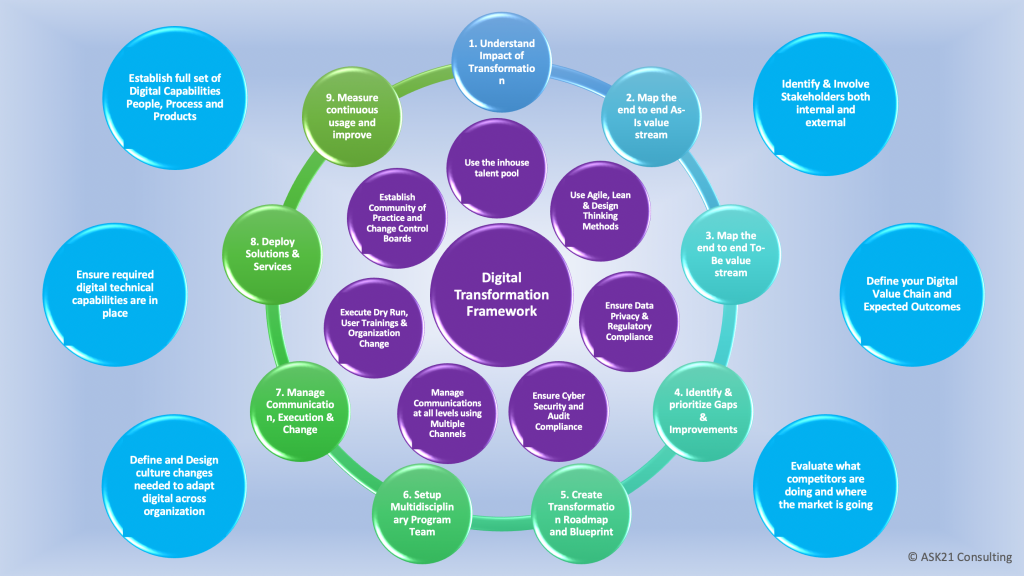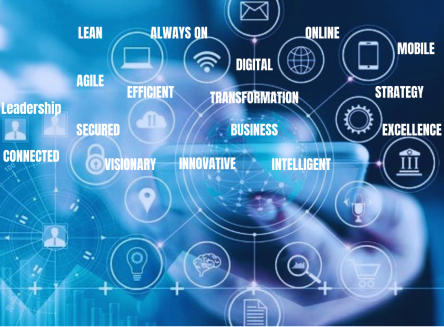Digital Transformation is a large commitment for organizations to change how it works, thinks and generates its business. Everything has to change to think, work and act digitally across the entire organization.
For being successful in making the leap for digital transformation, the organizations must follow a solid framework along with talents from both inhouse employees and outside partners. The digital transformation scope must also cover the landscape of the business partners to ensure they are equally digital equipped to work and deliver seamlessly.
The digital transformation framework provides a well thought through roadmap steps that can be applied to any organization to achieve transformation goals with agility, speed and accuracy. Digital transformation framework along with organizations’ digital value chain helps define organizations full path to succeed digitally.
Let’s do a quick run through on Digital Transformation Framework steps and supporting areas for achieving first time right successful transformation across the organization.

Step 1: Understand Impact of Transformation – Organization must clearly articulate and know what’s in it for them, why do they need to transform and what will be its impact across the organizations, taking in account all internal and external stakeholders involved. Eventually part of this is what the board of management will use for communicating towards the entire organization.
Step 2: Map the end to end As-Is value stream – This is an important step where the organization lays down its as is value stream on how their current business works. Full End to End mapping must be done involving talents from all divisions. It will also be useful to map the processes up to 3 sub levels deep to make it meaningful to understand processes and eventually gaps and improvements.
Step 3: Map the end to end To-Be value stream – Once the As-Is flows are mapped the important and often difficult step is to map the To-Be value stream. This can be achieved by taking input and lead from external partners hired for digital transformation. It can be also achieved by identifying gaps, manual steps, Lean waste in the processes and repetitive as well as duplicate work. The To-Be process map should result in automation and standardization of work. It should improve productivity and efficiency as well as competitive technology edge.
Step 4: Create a full list of Gaps and Improvements identified – Ensure the list is prioritized and owners assigned to ensure who would own and help drive which gaps and improvements. Eventually it will be a team work and many more people including technical IT inhouse and outside team members will be involved. The prioritization will set the tone for which are the important must have items that will create most of the impact and must be done first. As the list could be long, MOSCOW method can be applied to come to a shortened must have list.
Step 5: Create Transformation Roadmap and Blueprint – The information collected from step 1 to step 4 can now be converted to a transformation roadmap and blueprint documents. As this will be a long program involving multiple projects and tasks with dependencies, it will need to be well defined and executed with Lean, Agile and Design Thinking methods. The roadmap and blueprint will also ensure all compliance and audit related activities are well covered in the scope.
Step 6: Setup Multidisciplinary Program Team – Once the roadmap and blueprints are approved, the core program team can now setup the full Multidisciplinary program team required for various phases and projects to initiate execution. Inhouse talents as well as external partners must be onboarded to form the team.
Step 7: Manage Communication, Execution & Change – Initial communication of the program roadmap and blueprint must be shared widely across the entire team. The Daily dashboards and tracking and weekly/bi-weekly steerco updates and measurement metrics along with the definition of done must be communicated. The execution standards like Agile (Scrum or Scaled Agile) and Lean methods must be well communicated and ensure the team is trained to operate seamlessly. This is also the step where most of the technical execution and readiness takes place. So this step will require a lot attention and energy from everyone in the program.
Step 8: Deploy Solutions & Services – Once various tracks and projects have completed their execution, the important step of testing, cutover and release management comes up. In this step user acceptance testing, rework and sign offs on definition of done are achieved for all projects and for the entire program as a whole.
Cutover activities planning including data migration and phase in / phase out of systems / solutions / services is planned. User trainings are done for all. The interdependencies including exact sequence, date and time along with primary and backup owners for each cutover activity are confirmed. This also involves getting our partners ready to cutover and release. Communication of release and cutover command center for effective release management are put in place. Multiple checkpoint meetings and Go/No-Go signoffs are achieved. Point of no return is clearly mentioned and underpinned.
Go Live is achieved and first set of end-to-end golden transactions are carried to ensure entire process, people and systems are working as expected. Upon completion of the golden transactions the ramp up towards business as usual gets kicked off and generally with in 1 to 2 weeks of go live full ramp up and business as usual stage is achieved. Alongside from the day of go live 24×7 support to fix any teething issues is put in place. All transactions are tracked and progress reported on daily basis to ensure full control and attention on priority basis to keep the business smooth. This is also the step where best teams and team members are awarded/rewarded for their efforts. Overall team’s success celebrations are done.
Step 9: Measure Continuous usage and improve – In general the program team and its support structures continue for 6 to 8 weeks post go live to ensure a full cycle of 1+ month or even 2 months are done before concluding the closure of the program. This is also the step where community for practice (CoPs) are setup for users to interact with key users and subject matter experts. CoPs are online discussion forums of specific function, division or process experts and users to interact even after the program is closed.
Change control boards are also implemented to ensure changes are submitted, reviewed and approved through a board consisting of multi-disciplinary team that can approve/reject the changes. It serves both the purposes, one it to ensure continuous improvements are done to keep the business running and second is reject any unwanted changes that can lead to Lean waste again.
The Digital Transformation Framework ensures a successful implementation of organization’s digital needs of installing a new brain that can change how the organization functions as a whole, how it innovates (thinks) and how it operates (acts) to achieve its results.
Do look out for my second article covering 9 important areas that must be taken care for effective digital transformation and to make it successful.

